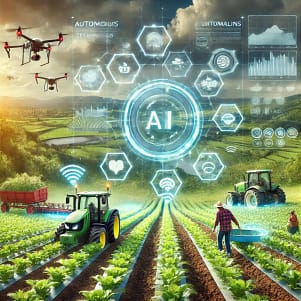Introduction – AI in Agriculture
Artificial Intelligence (AI) is revolutionizing agriculture by increasing efficiency, reducing waste, and improving crop yields. With the world’s population expected to reach nearly 10 billion by 2050, food production must rise by approximately 70% to meet demand. AI-driven technologies such as machine learning, computer vision, and robotics are playing a crucial role in addressing this challenge. This paper explores the impact of AI in agriculture, highlighting key areas such as precision farming, automated machinery, pest and disease detection, and supply chain optimization.

Precision Farming
Precision farming, also known as precision agriculture, leverages AI to optimize the use of resources such as water, fertilizers, and pesticides. Through data-driven decision-making, farmers can maximize yields while minimizing environmental impact.
- Soil and Crop Monitoring: AI-powered sensors and drones collect real-time data on soil health, moisture levels, and crop growth. Algorithms analyze this data to determine optimal planting and harvesting times.
- Predictive Analytics: Machine learning models process historical and real-time data to predict weather patterns, soil conditions, and disease outbreaks, helping farmers make proactive decisions.
- Variable Rate Technology (VRT): AI guides precision application of inputs like fertilizers and pesticides, ensuring only necessary amounts are used. This reduces costs and minimizes environmental impact.
Farming Tools – Click Here
Automated Machinery
AI-driven automation is reducing the need for manual labor and increasing the efficiency of agricultural operations.
- Autonomous Tractors and Harvesters: Self-driving tractors equipped with AI navigate fields, plow, plant, and harvest crops with minimal human intervention. These machines increase productivity and reduce labor shortages.
- Robotic Weed Control: AI-powered robots use computer vision to distinguish between crops and weeds, allowing for precise herbicide application or mechanical weed removal.
- Drone Technology: AI-enabled drones monitor crops, detect irregularities, and even spray pesticides with pinpoint accuracy, reducing resource waste and improving plant health.
Pest and Disease Detection
AI enhances early detection and control of pests and diseases, reducing crop losses and promoting sustainable farming.
- Computer Vision for Plant Health: AI-powered imaging systems analyze leaf patterns, color changes, and plant structures to identify diseases and nutrient deficiencies before they become widespread.
- AI-Powered Pest Identification: Machine learning algorithms process images from the field to detect pest infestations and recommend targeted interventions.
- Automated Spraying Systems: AI enables precision spraying, reducing excessive pesticide use and lowering costs while maintaining crop health.
Supply Chain Optimization
AI streamlines agricultural supply chains by improving efficiency, reducing waste, and enhancing food distribution.
- Yield Prediction Models: AI predicts crop yields based on historical and current data, helping farmers plan sales and distribution more effectively.
- Smart Logistics: AI-driven supply chain management systems optimize transportation routes, reduce spoilage, and improve market access for farmers.
- Market Forecasting: AI analyzes global market trends, weather conditions, and consumer demand to help farmers and agribusinesses make informed decisions.
Challenges and Limitations
Despite its potential, AI in agriculture faces several challenges:
- High Initial Costs: Implementing AI-driven technologies requires significant investment in infrastructure, which can be a barrier for small-scale farmers.
- Data Privacy and Security: The collection and analysis of large amounts of agricultural data raise concerns about ownership and data protection.
- Technical Knowledge Gap: Farmers may need training to effectively use AI tools, necessitating government and industry support for digital literacy programs.
Conclusion
AI is transforming agriculture by enhancing efficiency, sustainability, and profitability. While challenges remain, ongoing advancements in AI and increased accessibility of technology will drive widespread adoption. With AI-powered precision farming, automation, and supply chain optimization, agriculture is poised to meet the demands of a growing global population while reducing environmental impact.
0 Comments